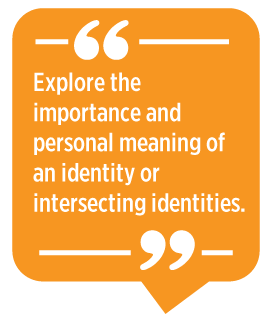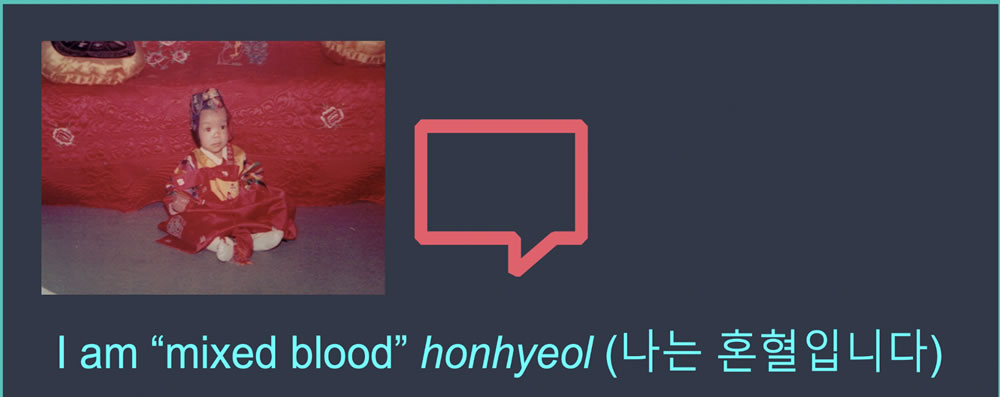|

Advancing social justice—equitable and inclusive
participation—in English language classrooms has become paramount in order to
cultivate intercultural competence among multilingual learners (MLLs).
Delivering activities designed to empower the multiple and overlapping
identities of MLLs has the effect of resituating their critical language
narratives from the periphery to the core of the curriculum.
The question for instructors then becomes: How can
activities be designed to place the multiple identities of students at the
epicenter of a socially just classroom?
Embracing Multiple Identities
In this article, we draw upon Social
Justice Standards: The Learning for Justice Anti-Bias
Framework (Chiariello et al., 2022). Of the four domains
delineated in the standards (identity, diversity, justice, and action), we
focus here on identity, highlighting the recurring theme of multiple
identities. Following are the identity anchor standards from the framework (p.
1):
Identity
-
Students will develop positive social
identities based on their membership in multiple groups in society.
-
Students will develop language and historical and
cultural knowledge that affirm and accurately describe their membership in
multiple identity groups.
-
Students will recognize that people’s multiple
identities interact and create unique and complex individuals.
-
Students will express pride, confidence and
healthy self-esteem without denying the value and dignity of other
people.
-
Students will recognize traits of the dominant
culture, their home culture and other cultures and understand how they
negotiate their own identity in multiple spaces.
Our objective is two-fold. First, we, as
social justice practitioners, serve as facilitators who strive to create brave
spaces, such as nonjudgmental circles (in synchrony with Native American
traditions) and communities of belongingness for MLLs. Second, we develop
materials and activities that empower MLLs to include and share their stories within a safe, affirming classroom
community.
4 Activities for Creating Brave Spaces and Communities
of Belongingness
In the following sections, we describe the purpose,
preparation, and procedure for four sample activities that accomplish these
goals.
1. Identity Mapping and Story
Sharing
 Purpose: To begin guiding
students through the process of exploring their intersecting identities Purpose: To begin guiding
students through the process of exploring their intersecting identities
Preparation and Materials:
Paper and pen, or access to word processing software. (Optional: a written or
spoken text on identity, e.g. Chimamanda Ngozi Adichie’s TedTalk, “The
Danger of a Single Story,” to introduce the topic.)
Procedure
-
Introduce the notion of identity (e.g., religion,
race, gender, profession) through the use of a short article, talk, and/or discussion
questions.
-
Students brainstorm identities in small groups
and then pool their ideas in a class discussion.
-
Students create a three-by-three table to form a
total of nine squares. In each square, they enter one of their identities (see
Figure 1).
|
Teacher |
Communicator |
Middle aged |
|
European ancestry |
American and French |
Speaker of English, French, and Russian |
|
Female |
Cisgendered |
Mother |
Figure 1. Identity map
sample.
-
You can remind students that it is neither
desirable nor possible to include all one’s identities in the nine squares of
the identity map. Students should select the identities that are most
meaningful to them personally. You might also encourage students to consider
identities that are both important to their sense of self as well as unwelcome
labels that others have projected onto them.
-
After completing their identity maps, students
reflect on stories related to their identities. For example, the time the
student overheard an unwelcome comment about her hijab or the party the
student’s family held to celebrate her college graduation. Have students write
at least one identity-related story as a journal entry.
-
If comfortable, students may share either their
full identity maps or one or two identities with a partner or small group. They
can also tell each other the identity-related story they wrote in their journal
entry.
-
This identity map can be used as a springboard
for a variety of other activities, such as the following Activities
2–4.
2. Creating an “I Am” Poem and
Delivering a Poetry Slam
Purpose: Over two lessons, to
reflect on and compare how one’s self-identity differs from societal
perceptions and constructions of the “Other”
Preparation and Materials:
Your visual aid or photograph to model your “I Am” poem. Have each participant
bring their own visual aid or photograph for their own poems. In alignment with
Native American and restorative justice practices, place chairs in a circle.
The circle provides a sense of equality and belongingness in the
group.
Procedure
-
Invite each participant to join in a
circle.
-
Model the activity by showing each circle member
your photograph or visual aid (see Figure 2), and read aloud your poem (see
Figure 3) as the visual aid or photograph passes through the hands of each
circle member.
-
For the following lesson, have each circle member
bring a visual aid or photograph and their own “I Am” poem. For intermediate
levels (B1–B2),
students would just make “I am” statements for each line. For the advanced
levels (C1–C2),
students have more flexibility, as suggested by the example in Figure
3.
-
Participants join the circle. Taking turns, each
circle member passes their visual aid or photograph to other members of the
circle as they recount their “I Am” poem. You might not want to have a time
limit for each circle member. Rather, encourage each circle member to engage in
the art of poetry slamming and storytelling—without limits. After each circle
member shares their “I Am” poem, the circle, as a collective, thanks the
storyteller for sharing their story with the circle at
large.

Figure 2. Visual aid for an “I
Am” poem. (Click here to enlarge)

Figure 3. Example of an “I am”
poem. (Click here to enlarge)
3. Double-Entry Journal
Storytelling
Purpose: To examine and relate
to poem excerpts addressing the visibility, invisibility, multiplicity, and
intersection of “Other” identities
Preparation and Materials:
Provide a poem for modeling. (In this example, we use “Others
Are Us” by Nathalie Handal.) Create a two-column journal for each
participant (see Figure 4). Place chairs in a circle.
Procedure
-
Create a circle.
-
Invite each circle member to select three quotes
from the poem and record them in the left column, including the line number of
the poem, and then write what each excerpt means to them and how they connect
to it in the right column.
-
Model the selection of poem excerpts and
demonstrate how the circle members may share their individual connections and
interpretations of the poem.
-
Taking turns, each circle member shares
double-entries with the rest of the Double-Entry Journal Circle. You might want
to allocate an appropriate time limit (3 minutes) for each
participant.
-
Discuss similarities and differences in poem analyses
and interpretations in terms of our own individual and societal assumptions and
perceptions about identity.
-
Compare and contrast what accounts for the
variances regarding how one self-identifies vis-a-vis societal constructions
(and perceptions) of the identities of the “Other,” as well as the phenomenon
of “being visible” and “being invisible.” After each circle member shares their
double-entries, the circle, as a collective, thanks the storyteller for sharing their story with the circle at large.
|
Quotation |
Commentary/Connection |
|
“He said I was
different because I was dark” (Handal, 2021, Line 1). |
This quotation
really resonated with me. Why? In the African-American and Korean cultures, the
color of one’s skin is paramount. Case in point, in Korea my maternal
grandparents’ servants were instructed to “keep me out of” the sun. Since I was
racially mixed, my grandparents wanted to make sure that I was not “too dark.”
Moreover, people who work in the sun are placed in a different social class.
Hence, my grandparents did not want me to be mistaken for a manual
laborer. |
Figure 4. Sample double-entry
journal.
4. Identity-Based Poster
Presentations
Purpose: To explore the
importance and personal meaning of an identity or intersecting
identities
Preparation and Materials: A
small poster board or access to an online platform (e.g., Padlet) for creating
a poster-like document.
Procedure
-
From their identity maps (Activity 1), students
choose one or more identities that are particularly meaningful or important to
them.
-
Students write multiple journal entries about
their identities. Here are some suggested journal prompts:
-
Tell a story related to this identity or these
intersecting identities.
-
Write about people you know who share this
identity or these intersecting identities.
-
Describe how this identity or these intersecting
identities make you feel and either draw or collect images representing these
feelings.
-
Make a list of famous people (writers, artists,
politicians, scientists, etc.) who share this identity or these intersecting
identities.
-
Students create a poster based on their journal
entries. There is no “right answer” to what they include on their posters. Some
students might make a collage. Others might write a story. Still others might
create a word cloud.
-
Students share their posters with classmates,
describing why they chose a particular identity or intersecting identities and
the significance of each item on their poster.
Conclusion
These activities are just some of the many ways in
which instructors may engage students in the exploration of the identity
domain. Using the target language, MLLs are empowered to tell their stories. As
a result, they are forging greater connections with their classmates, affirming
positive social identities, and creating a sense of belongingness.
References
Chiariello, E., Olsen Edwards, J., Owen, N., Ronk,
T., Wicht, S. (2022). Social justice standards: The Teaching Tolerance anti-bias framework. (2018).
Teaching Tolerance. https://www.learningforjustice.org/frameworks/social-justice-standards
Handal, N. (2021). Others are us. Poetry,
217(6). Retrieved from https://www.poetryfoundation.org/poetrymagazine/poems/155502/others-are-us.
Nancy Kwang
Johnson, MAT-TESOL (USC), MPA, PhD (Cornell
University, Government), CATESOL Education Foundation president, CATESOL DEI
chair and founding executive director of the MA in International Affairs
program (University of New York Tirana), has two decades of higher education
experience in Albania, Canada, France, Senegal, Serbia, and the United
States.
Nicole
Brun-Mercer is currently the associate
director of English Language Support Programs at Boise State
University. For more than 20 years, Dr. Brun-Mercer has taught English and
trained teachers in France, Guinea, Russia, Switzerland, and the United States.
She has published and presented professionally on materials development, DEIB
(diversity, equity, inclusion, and belonging), corpus linguistics,
lexicogrammar, reading, and composition. |